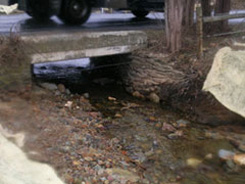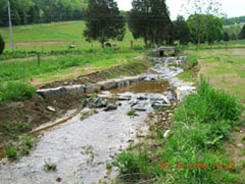Projects:
York County – Wildlife For Everyone Foundation teams up with US Fish & Wildlife Service and PENNDOT to restore Bald Eagle Tributary, York County, PA
In 2006, a Compliance Violation was issued to the Pennsylvania Department of Transportation (PENNDOT), requiring the restoration of the tributary to Bald Eagle Creek near the SR 2051 culvert bridge crossing. The primary goal of the project was to restore the channel to its natural dimensions in order to facilitate the transport of sediment, and to prevent deposition within the culvert bridge, which created a constant maintenance effort for PENNDOT.
A portion of this stream was actively meandering, and as a result was cutting into a steep bank, adding additional sediment to the stream. As part of the restoration plan, a portion of the channel was realigned in order to streamline the flow and thereby facilitate sediment transport through the system. The rest of the existing channel was reshaped to the proper dimensions by either building bank full benches or by cutting and sloping of the banks. A total of 23 log vanes were installed along the reach to direct flow away from the banks, while at the same time enhancing the aquatic habitat of the stream. Two rock cross vanes were constructed downstream of the culvert to maintain stream grade where excess dredging had occurred and to concentrate the flow in the middle of the channel. In order to minimize impacts from livestock on the property, three cattle crossing structures were installed at optimum positions along the reach; likewise, most of the stream was fenced in to deny cattle unlimited access to the stream and its banks.
For this project, the US Fish and Wildlife Service (USFWS) applied for the permits, developed the restoration plan, and provided construction services; PENNDOT provided construction support in the form of equipment; the Wildlife For Everyone Foundation (WFEF) assisted with the management of funds.
The primary benefits of this restoration project are: reducing sediment deposition around the culvert bridge; stabilizing the banks to reduce erosion and sediment input to the stream; and improving wildlife habitat by providing a healthy stream channel with natural log and rock features. The ecological value of the stream is expected to greatly increase.

Before: The gravel buildup under the SR 2051 culvert bridge was a constant maintenance effort for PennDOT. (Looking downstream.)

After: Two rock vanes direct the stream flow towards the center of the channel and help to stop erosion of the banks. This helps prevent excess sediment from being deposited. (Looking upstream)
